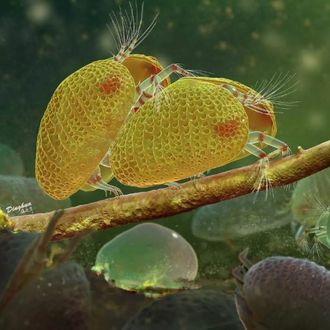
Huge sperm news: Scientists have just discovered the oldest sample of animal ejaculate in the history of the Earth, dating back 100 million years. But far more interesting than the record-breaking nature of the fossil is the sperm’s literal size, which is — to use the actual scientific term — “giant.”
According to the study, published in Proceedings of the Royal Society B: Biological Sciences, the sperm came from a previously undiscovered species of ostracod, which Live Science describes evocatively as “a crustacean that looks a shrimp dressing up as a clam for Halloween.” But the remarkable sample was not discovered inside the male creator’s body, as one might’ve assumed. Instead, it was found inside a female ostracod, who scientists believe got railed immediately before she was tragically entombed by tree resin in modern-day Myanmar.
Ostracods — a subclass of crustaceans, also known as “seed shrimp” — are exceptionally small, known to grow no more than a few tenths of an inch long. But the size of their loads? Giant. Although the scientists struggled to get a full measurement of any of the 50 full sperm cells stored in the lover’s body, they know the sperm cells to be at least 200 microns long. That’s at least a third of the ostracod’s body length and several times bigger than what human men have to offer.
Now apparently, it’s not unheard of for creatures to produce sperm that exceed the length of their bodies. While most animals produce an abundance of tiny swimmers, according to Vice, certain creatures — notably, modern ostracods — expend a great deal of energy to make a smaller number of absolutely gigantic sperm. In fact, some modern ostracods can shoot out sperm more than four times the length of the male’s body, which would be like a dude busting a 24-foot-long sperm cell. Bravo to ostracods, impressive well-hung kings, but no thank you!

